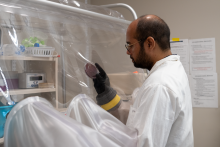The University of British Columbia today officially opens the new Earth Sciences Building, a state-of-the-art facility that will provide modern learning spaces for more than 7,000 students each year and leading-edge laboratories for hundreds of researchers.
“This magnificent building will enable us to provide undergraduate and graduate students with an unparalleled education in the earth sciences, as well as to continue developing knowledge and expertise in sustainable natural resource management to serve the industry in British Columbia and around the world,” says UBC President Stephen Toope.
“We expect more than 10,000 job openings for skilled workers in B.C.’s mining, oil and gas and mineral exploration industries by 2020, and UBC earth sciences graduates are going to fill those jobs and help grow these industries,” says Premier Christy Clark. “That’s why we are investing in facilities such as the Earth Sciences Building at UBC to ensure British Columbians are prepared for the jobs of tomorrow.”
The 17,500-square-metre Earth Sciences Building unites many of UBC’s natural resource research groups in collaborative lab spaces, and incorporates a lecture theatre complex and customized computer labs designed for interactive learning.
“Great facilities help create great graduates who in turn build great companies and institutions,” says UBC geology alumnus Ross Beaty, Chairman of Pan American Silver Corp. and Alterra Power Corp, and Chair of the UBC Earth Sciences Building Campaign.
“UBC’s world-renowned reputation for excellence in earth, ocean and atmospheric sciences is enhanced with this fine new building, which I am most proud of helping establish for future generations.”
UBC’s Earth Sciences Building was made possible by a $37.5-million investment from the BC Government, and to date, more than $26 million from the mineral exploration and mining communities as part of UBC’s start an evolution* campaign. Lead donors include Ross Beaty, Goldcorp Inc., Teck Resources Limited, Lundin Mining Corporation and Pan American Silver Corp.
For more information: science.ubc.ca/about/esb
*These gifts form part of UBC’s start an evolution campaign, the most ambitious fundraising and alumni engagement campaign in Canadian history. For more information, visit startanevolution.ubc.ca.
BACKGROUND | UBC EARTH SCIENCES BUILDING
Faculty of Science UBC Science is consistently ranked as one of strongest and most diverse faculties of science in Canada, and delivers high-quality undergraduate programs across 18 disciplines to 7,000 students. Over the past five years, the Faculty’s initiative to transform undergraduate science education – launched by Nobel Laureate Carl Wieman – has used evidence based-approaches to improve the classroom experience of thousands of students. UBC Science researchers have attracted $400 million in research funding over the past five years, and have included two Nobel Laureates, eight Fellows of the Royal Society of London, and more than 50 Canada Research Chairs. Also home to three natural history venues, the Faculty delivers outreach and community engagement programming to 8,000 K-12 students and teachers every year.
Building Features Designed by Perkins+Will Canada, the Earth Sciences Building (ESB) is constructed to LEED Gold standards, and is the largest panelized wood building and the largest application of cross-laminated timber (CLT) in North America. The building uses more than 1,300 tons of B.C. sourced and engineered CLT – each ton of dry wood products sequesters sufficient carbon to keep between 1.8 and 2.0 tons of CO2 from being formed.
ESB features modern research and teaching spaces, a state-of-the-art lecture theatre complex, seminar rooms, quiet study spaces, and common areas. Complementing the glass-shrouded Beaty Biodiversity Museum across UBC’s Main Mall, ESB features nine-metre tall high-head labs penetrating the first story with floor to ceiling windows. Clearly visible from campuses’ Main Mall, the labs will offer students and visitors a unique glimpse into the world-class earth science research conducted at UBC. The exterior walls of the building display massive polished slabs of rock samples, and exterior walls of the lecture theatres incorporate stone into curtain-wall glazing frames.
Building Occupants
Department of Earth, Ocean and Atmospheric Sciences UBC EOAS is the largest and most highly ranked earth sciences department in Canada, recognized internationally for its strong partnerships with industry. The new building provides 250 EOAS researchers with modern facilities that will enable them to investigate some of the most pressing challenges facing our world. From studying our planet’s origins to unearthing current and future environmental trends, EOAS faculty and students are uniquely positioned to advance solutions for mineral exploration, climate change, and environmental degradation.
Department of Statistics The UBC Department of Statistics houses 17 regular faculty members and 50 graduate students, divided between MSc and PhD programs. The department conducts research across a wide variety of areas, including biostatistics, environmental statistics, bayesean statistics and robust statistics. The department also offers statistical consulting expertise to industry via its Statistical Consulting and Research Laboratory.
The Pacific Institute of the Mathematical Sciences The Pacific Institute for the Mathematical Sciences (PIMS) was created in 1996 by the community of mathematical scientists in Alberta and BC, and subsequently Washington State and Saskatchewan. PIMS promotes research in and applications of the mathematical sciences to facilitate the training of highly qualified personnel, to enrich public awareness of and education in the mathematical sciences, and to partner with similar organizations in other countries.


